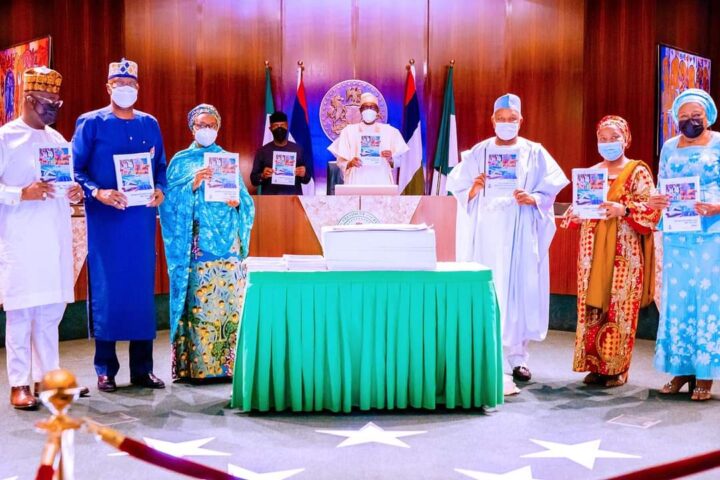President Muhammadu Buhari has launched the National Development Plan (NDP) for 2021 to 2025.
The president presented the document to the public at the council chambers of the presidential villa in Abuja before the weekly federal executive council (FEC) meeting.
During her opening remarks, Zainab Ahmed, minister of finance, budget and national planning, said the new plan would help Nigeria achieve robust development.
“The President graciously granted approval to my ministry in 2019 to develop a new national development plan to succeed both ERGP 2017-2020,” Ahmed said.
Advertisement
“It is very important to note that the Plan is a pointer to the type of Nigeria we all desire and encourages the use of science, technology and innovation to drive growth.”
She added that the plan is also in line with the attainment of various regional and global goals.
“I want to place on record that this plan is sufficiently comprehensive with the capacity to accelerate the attainment of various regional and global agendas, including the AU Agenda 2063, ECOWAS integration agenda 2050 and the Sustainable Development Goals 2030,” Ahmed said.
Advertisement
“In order to have the future we all desire, the plan is developed to play a sizable role in the product complexity space internationally and adopts measures to easing constraints that have hindered the economy from attaining its potentials, particularly, on the product mapping space.
“The plan provides for the implementation of major infrastructure and other development projects across the six geo-political zones and the opening up of opportunities for the rural areas to ensure balanced development and increased competitiveness.”
On his part, Clement Agba, the minister of state, budget and national planning, said that the NDP intends to be an all-inclusive plan for all Nigerians, especially women, young people, people with special needs and vulnerable people.
“From us in the Ministry of Finance, Budget, and National Planning, ours wasn’t a memo to council,” Agba said.
Advertisement
“What happened today was the unveiling of the National Development Plan by His Excellency, Mr President.
“You will recall that the National Development Plan 2021 to 2025, which is the successor plan to the Economic Recovery and Growth Plan was approved by the Federal Executive Council on November 10.
“The difference with this plan is that it provides a mechanism to engage, empower, and employ our teeming energetic youth.
“The plan puts opportunities for inclusiveness for young people, women, people with special needs, and the vulnerable ones, mainstreaming women’s gender into all aspects of our social, economic and political activities.
Advertisement
Agba said the plan would increase the country’s revenue to GDP ratio from 7 percent to 15 percent.
“This plan also has a financing plan to increase revenue to 15% of GDP. Currently, revenue to GDP is 7%,” he said.
Advertisement
“This plan also separates sports from youth and takes sports as a business. In the past, we have always had one volume, which is the plan itself. But this time, we have three volumes.
“Volume one is the main plan, and that’s what will be accessible to the public.
Advertisement
“Volume two is the prioritised and sequential list of programmes and projects that will be fed into the annual budgets.
“While volume three are the legislative imperatives. What volume three seeks to cover are those laws or policies that impede the private sector from being the main driver of the economy.
Advertisement
“And so, laws have been identified that need to be reviewed or changed. Policies have also been identified that need to be worked upon. So, Volume Two and Volume Three are not for the public.
“They are essential for the government to see what they need to do. Another difference between this plan and the previous plan is the issue of Integrated Rural Development. This plan takes rural development away from agric.
“It looks at how to bring in different levels of infrastructure to the rural areas with a view to discouraging rural-urban migration and ensuring that broadband technology gets to the rural areas, and that power supply, even if it’s an upgrade, it’s within the rural areas.
“And we begin to open up our rural areas. Another differentiating factor between this plan and the previous plan is that this plan has a strong implementation framework. And there is also a framework for monitoring and evaluation because it takes into cognisance, vertical, lateral and horizontal coordination.”
Add a comment






